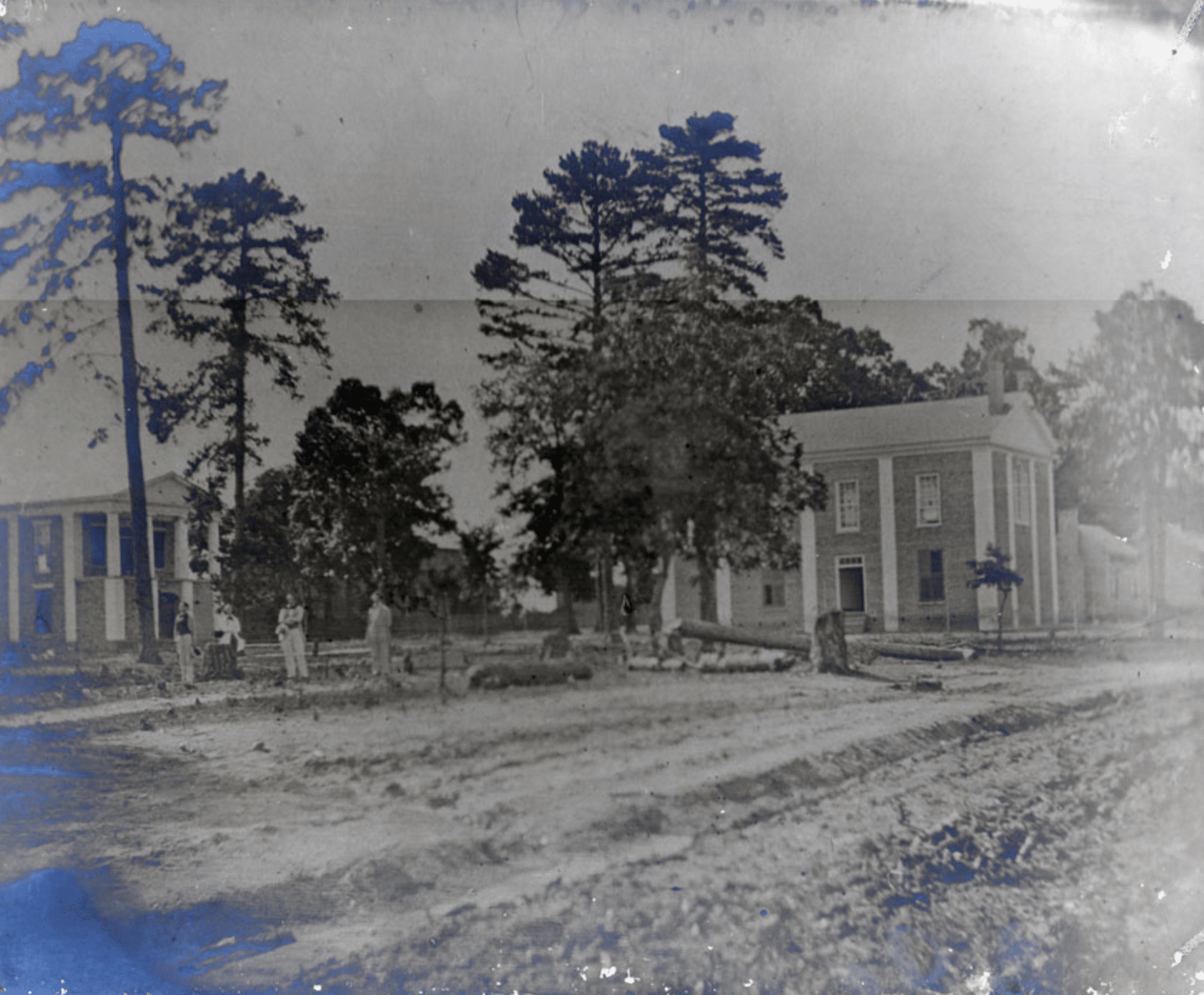DAVIDSON HISTORY
Life at Davidson College in the 1840s and 1850s

Davidson College buildings in 1850. (Screenshot from the college digital archives.)
Cornelia Shaw, in her history of Davidson College, writes of an unsigned sketch entitled “Davidson in the Forties,” which was found among the papers of Dr. Jethro Rumple, who graduated in 1850. It is one of only a few descriptions of college life at that time. Here are some excerpts:
“It was the day of small things with Davidson College in the decade of the forties…There were only three professors including the president, and they taught everything and all day long, even one class before breakfast. Well do we remember…how we used to awaken by the clanging of the bell at sunrise or before and rush to prayers and roll call, perhaps half-dressed and making our toilet on the way…and listened with dull ears and looked with half-closed but not devout eyes, while the rather stereotyped prayers were being repeated. Thence from the chapel to the lecture room below we wended our weary ways…The antebreakfastean [pre-breakfast] roasting over, we were generally prepared for refreshments, which ‘Old Aunt Dan’ and ‘Old Lew’ furnished at $6 a month, together with dinner and supper at the constitutional hour…we were not very reverential in our appellations in those days, having the bad habit of prefixing the word ‘old’ to the pronomen [first name] even of our venerable president along with our two professors…We regarded our venerable president [Reverend Samuel Williamson] as a living encyclopedia…It was a popular notion that he could have stepped into any classroom and heard any recitation as well as the regular professor and time has not erased the impression…On those long and perfervid days of June, July and August – for Commencement then came the second week in August – you might have seen [students] in the late afternoon under a large oak tree…with their long-stemmed pipes having an evening gossip. Some of them had on white trousers and coats and panama hats. Some wore long blue calico hunting shirts or study gowns, reaching below the knees. The topics of conversation would be various.”
With the town not more than a village, and very few students at the college, there was little for students to do, and they were compelled to make their own fun. This inevitably led to pranks. Shaw reports that “In 1849 the Faculty recorded that they had been ‘particularly grieved with the conduct of a few of the students during a part of the year.’ From some cause which is not known to us they seem to be dissatisfied; and they secretly perpetrated acts of mischief and disorder…”
One such prank involved the college bell, which was in a belfry just north of the chapel. One night the students burned down the belfry, and stole the bell. It “was taken in the woods and one night it would ring in the north, the next night in the south, being changed every night. Finally it was broken into small pieces and brought back to its old location.” Other pranks that year included “disturbing neighbors and in two instances by firing at them with a pistol and actually wounding one of them, the taking of the Bible from its place in the College Chapel, the tearing away the lining from the pulpit, and the scattering of shot and pebbles during prayers.”
Professor Elijah Frink Rockwell, who arrived in 1850, was the butt of some of these pranks. He was referred to as “Old Frink” and “The Fiddler,” and had a habit of reading as he walked to and from class. On one occasion a sophomore tied a goose to his teaching chair; on another he was first to arrive for morning prayers and discovered a large ram, which the students had dressed up and placed on the rostrum. Rockwell “had gotten nearly to the rostrum before he saw the ram. He turned and reached the door just as the ram reached him and with a butt of his horns landed the Professor out of the chapel.”
Another morning students dressed up an old grey horse and placed him on the rostrum. And on one memorable occasion, a wagon that belonged to a village resident was placed “on the extreme cone of the roof of chapel.”
In 1855, in response to such shenanigans, D.H. Hill, a graduate of West Point who was married to one of Robert Hall Morrison’s daughters and later a general in the Civil War, was hired as a professor and to improve discipline at the college. His inaugural address entitled “College Discipline” was widely recognized across the country.
Nancy Griffith
Nancy Griffith lived in Davidson from 1979 until 1989. She is the author of numerous books and articles on Arkansas and South Carolina history. She is the author of "Ada Jenkins: The Heart of the Matter," a history of the Ada Jenkins school and center.


